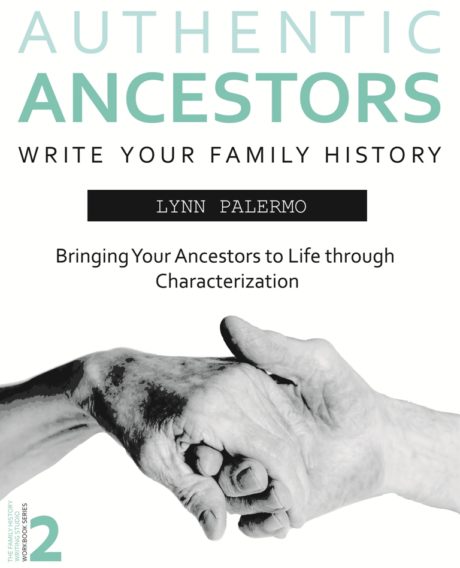When we fall in love with an ancestor on the page, we don’t fall in love with the fact that he is a 56-year-old farmer from Ireland with brown hair, a stalky build and always wears a hat. We don’t fall in love with the physical characteristics that we continuously get so caught up in knowing and inserting into our writing. (By the way, most readers will forget these facts.) What we tend to fall in love with is our ancestor’s motivations, their flaws, their vulnerabilities, their strengths. We don’t fall in love with their physical qualities, but with what’s at the core of them internally, what makes them real.
And yet, when we write about our ancestors to tend to only focus on their physical being. We also question if we don’t have a picture of them how can we possibly bring them to life on the page.
In the novella I am writing about my third great-grandfather I don’t know his physical description. I don’t have a picture of him. I don’t know the colour of his hair. It really is quite insignificant. It doesn’t progress the story forward. It doesn’t contribute to the plot, and it doesn’t allow my reader to see my ancestor more deeply.
Only a few physical details are available to me. But I’m not worried.
I do know his goals, his desires, his motivations. I know his fears, his vulnerabilities. I know his life story. I know his actions and reactions to events in his life. And from his actions, the people he associates with and his past I can bring him to life for my reader.
So how do you make your ancestor real on the page? There are many questionnaires available to help you to get to know your ancestor better. But you’ve got to use one that doesn’t just address their physical attributes, but that gets to the heart of their internal selves. (Warning shameless plug – We’ve got a great one in workbook #2 Authentic Ancestors with lots of info on bringing your ancestor to life on the page)
To know your ancestor completely, you’ve got to know the emotional truths in their being, the relationships, and the history that influenced them, and the way they chose to act in the world and as a result how they were perceived.
Let’s address these 3 big things so you can get to know your ancestor before writing.
1. WHAT DID YOUR ANCESTOR WANT AND WHY DID THEY WANT IT?
Figure out your ancestor’s primary goal. What is the one most urgent desire they have more than anything in the world? (Hint: This is probably the entire reason you’re writing this story. And it should be highly tied to your plot.
After identifying the goal, we have to dig deeper and discover the why behind it. For your ancestor to ring true, he can’t just want something arbitrary. It must have a higher meaning. Why do they want this thing so much?
Keep in mind, sometimes, what your character thinks they want and what they actually want are two different things entirely. Perhaps they believe they wish to conquer the world, but really they just want to make their father proud. Maybe they think they want to fall in love with someone, but what they need is to love themselves.
-
WHAT HAPPENED IN YOUR ANCESTOR’S PAST THAT INFLUENCED HOW THEY BEHAVED?
Your ancestor’s actions did not happen in a void. Things have happened in your ancestor’s past, and those things influenced their actions and choices.
If your ancestor watched her parents work as a peasant farmer never getting ahead, she might have a strong desire to own land or maybe get an education. If your ancestor lost a parent at a young age, he might feel strongly about becoming a doctor and healing the sick. If your ancestor came from a long line of military men he may feel loyalty to do the same. Or perhaps he had a want to rebel against serving in a war. Their actions and choices show these thoughts. Their past experiences influenced their decisions.
Map out a historical timeline of your ancestor’s life. Record all the significant milestones, births, marriages, deaths, careers, military, etc. Identify the 5 most significant, most life-changing and influencing moments they’ve ever had.
Try to sum up your ancestor’s life with those 5 moments. What would those moments be? Why?
CONSIDER How RELATIONSHIPS Affected Your Ancestors
“Birds of a feather flock together.”
Like-minded people tend to hang together. But, it also works in the opposite direction. People who hang together become like-minded. It’s said that your thoughts and behaviors are a compilation of the 5 people you are most intimate with. Those you surround yourself with day-to-day influence you more than you realize. Sometimes that’s a good thing, sometimes not.
Who are the 5 people who your ancestor hangs out with? Friends? Family members? Coworkers? Spouse? Consider how these relationships shaped your ancestor’s perspective on the world. Their behavior? What does your ancestor’s relationship with their mother, wife, children look like? Who does your ancestor trust the most? Who would your ancestor call if they had a problem and needed advice? What does your ancestor’s relationship with their significant-other look like? Are these relationships positive or negative?
Of course, we’ve all experienced relationships that weren’t positive. We’ve all ran into someone we didn’t get along with for some reason. Your ancestor did too. Consider who that may have been. What happened to cause this bond to turn negative. How did this relationship shape them?
3. HOW DID YOUR ANCESTOR BEHAVE AND ACT IN THE WORLD?
Behavior may be aligned with your ancestor’s beliefs, or it may seem to be wholly misaligned with your ancestor’s beliefs. But this is the perception that your ancestor gives off to the world. This is how other people perceive your ancestor because they don’t have access to their innermost thoughts.
Was your ancestor outgoing? Did they talk a lot because they’re internally nervous? Maybe your ancestor always acted out of spontaneity, or carefully planned every move ahead of time. Perhaps your ancestor planned their words before they said them. Was your ancestor action-heavy and continually going places and doing things. Or was your ancestor shy and locked inside their own head? Did they speak quickly or slowly? Perhaps they felt the need to be proper and ladylike all the time. Maybe they felt the need to show dominance. Maybe they worried so much about what other people thought, or they didn’t care at all and did their own thing against social norms.
How did your ancestor behave in public? How did they present themselves? How did they act? What is the vibe they gave off to the world? How does the world view them?
Here’s An Exercise For You
Now here’s an exercise to help you flesh out your most authentic ancestor. Imagine you met your ancestor at a party and you asked them the classic question, “Tell me about yourself.”
What would they say? What aspects of their life would they choose to highlight? What successes would they bring up? What interests might they want to talk about? What basic facts do they feel they need to share with you? What positive things do they think they need to convey for this person (who doesn’t know them) to perceive them accurately?



